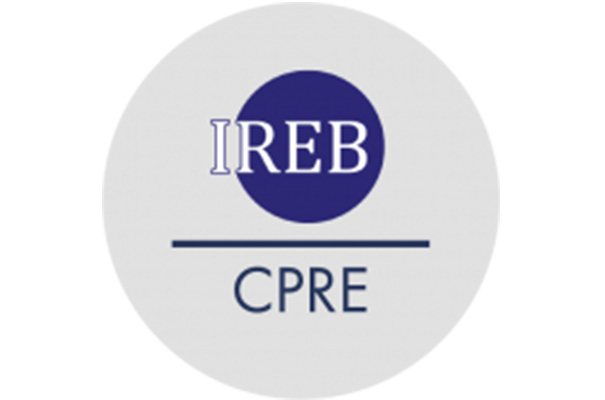Skip to content
Course content
- Introduction
- Background to ontology modelling
- Anatomy of a machine-interpretable ontology
- Benefits of ontologies in Business Analysis
- Ontology development and deployment
- Course wrap-up
Course Outline
- Przegląd sylabusu (planu) wiedzy wymaganej do egzaminu certyfikacyjnego
- Omówienie tematów nieobjętych programem kursu „Podstawy inżynierii wymagań i analizy”, ale wymaganych do egzaminu, oraz zapoznanie się z terminologią
- Skąd się biorą, jak odpowiadać na pytania egzaminu próbnego?
- Wykonanie i omówienie 40 pytań próbnych
Intro
- Start the process
- Completion of the process
- Task and simple workflow
- Send a message
- Receiving a message
- Specify the type SCRIPT
- Specify the type TASK
Subprocess
- Activity calling
- Ad-hoc sub-process
- Subprocess transaction
The initial event
- Message
- Cyclical start the process
- Signal
- Condition
- Start the process of the event one of the n
- Multiple events starting
Final Events
- Message
- Signal
- Error
- Escalation
- Cancellation
- Completion of the process at one level
Intermediate events
- Events capture
- Activating events
- Limit events
- The event subprocess
- Time event in the flow of normal
- Time event activity at the border
- Message activating
- Message to intercept the flow of normal
- Gateway event type
- Error
- Escalation
- Signal
- Communication between tracks Exception Messages
Structures connecting and sharing a path in the process
- Parallel division
- Exclusive division
- Conditional division
- Combining alternative paths
- Combining parallel paths
- Combining conditional paths
- Discrimination paths
Create structures that support the unique flow
- Types of exceptions
- Practices for handling exceptions
Repeated practice activity
- Loop
- Multi – instance activity
- The batch processing
Sub-process such transactions
- The concept of transaction
- Offsetting activity
- Event CANCEL
- Construction of a compensation mechanism
Module 1: Traditional Development Approaches
- 1.1 Overview of Sequential, Predictive Development Approaches
- Description of sequential, predictive ‘Waterfall’ approaches
- Timeline of evolution of Waterfall approaches
- 1.2 Strawman Waterfall
- Dr Winston Royce’s Waterfall model
- Benefits of Waterfall for controlling projects
- Royce’s “Inherent risks”
- 1.3 V-Model
- Early verification and validation
- Benefits of V-model
- 1.4 Incremental Models
- Example of Rational Unified Process
- Incremental delivery
- Breaking down scope and managing risk
- 1.5 When to Use Waterfall
Module 2: Prince2 Overview
- 2.1 What is Prince2?
- Definition and origins
- Prince2 Certifications: Foundation, Practitioner, Agile
- Benefits of Prince2
- 2.2 Prince2 Methodology
- Roles – Project manager, customer, user, supplier, project board
- Management Techniques – Project assurance, project support
- Scope – Interaction with contracts and contractual management
- Controlling Change – Risk, quality, and change management
- 2.3 Prince2 Process Model
- Directing a project
- Starting up a project
- Initiating a project
- Managing stage boundaries
- Controlling a stage
- Managing product delivery
- Closing a project
- Planning
Module 3: Agile Overview
- 3.1 Historical Overview
- Timeline of evolution of ‘Agile’ ideas 90s to present
- Early Agile approaches – Scrum, XP, DSDM
- Agile Developments – Kanban, BDD, DevOps, Scaling
- 3.2 The Agile Manifesto
- Background to creating the Manifesto
- Agile Manifesto overview
- Individuals and interactions over processes and tools
- Working software over comprehensive documentation
- Customer collaboration over contract negotiation
- Responding to change over following a plan
Module 4: Agile Principles
- 4.1 The 12 Agile Principles
- Group discussion on each principle
- 4.2 Summary of Agile concepts
- Iterative planning and development
- Continuous improvement
- Continuous learning
- Collaboration and face-to-face communication
- Collective accountability
- Cross-functional teams
Module 5: Agile Project Management with Scrum
- 5.1 The Scrum Framework
- Overview – Scrum Guide 2016
- Scrum roles and responsibilities – Scrum Master, Product Owner, Team
- Scrum events – Sprint, Sprint Planning, Review, Retrospective, Daily Scrum
- Scrum artefacts – Product Backlog, Sprint Backlog, Product Increment
- 5.2 Agile Project Management Principles
- Empirical Process Control
- Iterative planning and reporting
- Continuous Improvement and retrospection
- Resource management and teams
Module 6: Software Testing
- 6.1 Testing Fundamentals
- The Fundamental Test Process
- Planning, Analysis & Design, Execution, Evaluation, Closure
- Test levels – unit, integration, system, user acceptance
- Test approaches – requirements-based, risk-based, experience-based
- Test design techniques – white-box, black-box techniques
- 6.2 Agile Testing
- Agile Testing Quadrants overview – test strategy, planning
- Test-driven development
- Test automation principles – test automation pyramid
- 6.3 Test Types
- Technology-facing tests that guide development
- Unit testing, TDD, smoke tests
- Business-facing tests that guide development
- Story tests, examples, acceptance testing
- Business-facing tests that critique the product
- Exploratory testing, Alpa/Beta testing, UAT
- Technology-facing tests that critique the product
- Performance testing, usability, quality attributes
Module 7: Traditional Business Analysis
- 7.1 What is Business Analysis?
- Business analysis and the business analyst
- Levels of business analysis – enterprise, project, operational
- Business Analysis principles
- 7.2 IIBA BA Book of Knowledge – Knowledge Areas
- Business Analysis Planning and Monitoring
- Elicitation and Collaboration
- Requirements Life Cycle Management
- Strategy Analysis
- Requirements Analysis and Design Definition
- Solution Evaluation
Module 8: Agile Business Analysis
- 8.1 Agile Business Analysis Considerations
- Iterative development
- Cross-functional teams
- Collaboration between business and technology areas
- 8.2 Behaviour-Driven Development Overview
- Origins in TDD and recent developments
- Definitions – BDD, ATDD, Specification by Example
- 8.3 BDD Activities
- Focus on features that deliver business value
- Derive features collaboratively
- Keep options open
- Use concrete examples to illustrate features
- Write executable specifications
- Create living documentation
- 8.4 Agile BA Techniques & Tools
- Business value definition
- Personas
- Impact Mapping
- Real options
- User Stories and acceptance criteria
- Relative estimation
- Given-When-Then template
- Tool support for BDD
Introduction and Overview
The what and why of business process re-engineering (BPR)
- Maximising competitive advantage through radical redesign
- The need for re-engineering
- Determining what re-engineering is and is not
- Focusing on the business process
- Achieving cost reduction and revenue generation goals
Applying the proven CLAMBRE/UML framework for re-engineering
- Modelling standards: UML and BPMN
- Customers vs. stakeholders
- Identifying activities and information structure
- Creative right-brain thinking
Targeting the Customer
Exploring the customer interface
- Expanding customer roles with aggregation
- Refining customer types using generalisation
- Establishing an accurate customer profile
Documenting customer values and needs
- Service provision vs. product supply
- Evaluating customer satisfaction: quality, flexibility, speed, cost, service
- Categorising customer relationships using the PRIDE checklist
- Assessing how effectively the business process meets customer needs
Modelling the Business Process
Pinpointing processes for re-engineering
- Uncovering core business processes
- Choosing suitable metrics to assess process performance
- Detecting business process antipatterns
- Presenting findings to senior management
Describing worker roles and responsibilities
- Identifying anomalies in worker roles using cross-reference matrices
- Mapping a business process using UML activity diagrams
- Partitioning activities between roles
Analysing the Business Process
Detailing business processes
- Selecting appropriate UML tools
- Scoping the process with UML use case diagrams
- Pinpointing key business actors
- Modelling alternative workflows
- Capturing ineffective business activities
Exploring the business structure
- Revisiting organisation infrastructure
- Mapping information using class diagrams
- UML business stereotypes
- Designating process architecture with communication diagrams
- Removing restrictive structures
Redesigning the Business Process
Maximising the benefits of information technology
- Web-enabled technology
- Interaction through social spaces
- Designing future-proof business systems
- Business intelligence solutions
- Enterprise Information Systems
Redefining customer-process boundaries
- Adapting the business process to benefit specific customer types
- Integrating and capitalising on technology opportunities
- Personalising the process
- Meeting and exceeding customer expectations
Creating the new process using the best business practice
- Incorporating business patterns
- Resolving process anomalies
- Comparing strategic alternatives
- Ensuring durable, reliable information management
Rolling Out the Re-engineered Process
- Re-educating the workforce
- Linking metrics with customer satisfaction
- Supporting ongoing process improvement
- Monitoring and measuring results
- Demonstrating success
- What is Business Analysis?
- Business Analysis Planning and Monitoring
- Requirements Elicitation – Gathering Information
- Requirements Management and Communication – Defining the process
- Enterprise Analysis – Defining the problem
- Requirements Analysis and Documentation – Defining the Solution Model
- Solution Assessment and Validation – Supporting the Balance of the Product Life Cycle
- Underlying Competencies for BA – soft skills
- Techniques for Requirement gathering process
- UML modelling and prototyping (Rational Rose, Visio, Erwin, Visual paradigm, Enterprise Architect).
- Project management (procurement management, Risk management, proposal writing).
- SDLC (Traditional methodologies and Agile methodologies) models, Quality standards (ISO, CMMI) and Testing (Manual and Automation).
- Different domains introductions (eg Telecom, Banking, E-Gov, Travel and hospitality, Health care, BPO, Engineering services).
Introduction to IIBA Certification
- Overview of certification process & requirements
- BABOK® Framework
- Knowledge Areas
Business Analysis Planning & Monitoring
- Overview, Inputs and Outputs
- Planning the Requirements Approach
- Identifying and Analysing Stakeholders
- Deciding how Requirements will be Managed and Traced
- Estimating BA Activities
- Planning of BA Communications
- Determining Requirements Metrics for Monitoring and Reporting
- Techniques for Planning
Requirements Elicitation
- Overview, Inputs and Outputs
- Prepare for Elicitation
- Conduct Elicitation Activity
- Document Elicitation Results
- Confirm Elicitation Results
- Techniques for Elicitation
Requirements Management and Communication
- Overview, Inputs and Outputs
- Manage Solution Scope and Requirements
- Manage Requirements Traceability
- Maintain Requirements for Re-Use
- Prepare Requirements Package
- Communicate Requirements
- Techniques for Requirements Management and Communication
Enterprise Analysis
- Overview, Inputs and Outputs
- Define Business Need
- Assess Capability Gaps
- Determine Solution Approach
- Define Solution Scope
- Define Business Case
- Techniques for Enterprise Analysis
Requirements Analysis
- Overview, Inputs and Outputs
- Prioritise Requirements
- Organize Requirements
- Specify and Model Requirements
- Define Assumptions and Constraints
- Verify Requirements
- Validate Requirements
- Techniques for Analysis
Solution Assessment and Validation
- Overview, Inputs and Outputs
- Assess Proposed Solution
- Allocate Requirements
- Assess Organizational Readiness
- Define Transition Requirements
- Validate Solution
- Evaluate Solution Performance
- Techniques for Solution Assessment and Validation
Underlying Competencies
- Analytical Thinking and Problem Solving
- Behavioural Characteristics
- Business Knowledge
- Communication Skills
- Interaction Skills
- Software Applications
BPMN 2.0 in context of Business Process Management
- Business Process definition
- How to model Business Process
Sub-model Types of Processes
- Choreographies
- Collaborations
- Conversations
Modeling Orchestration
- Private non-executable (internal) business process
- Private executable (internal) business process
- Public processes
Basic BPMN Symbols in Examples
- Activity
- Gateways
- Events
- Sequence Flow
- Message
- Artifacts
Modeling Collaboration
Message Flow
Process Design
Activities
- Activity vs Task
- Human Interactions
- Types of Tasks
- Sub-Process
- Call Activity
- Loop Characteristics and Multi-Instance
Items and Data
Events
- Concepts
- Start and End Events
- Intermediate Events
- Trigger
- Types of Events
- Message
- Timer
- Error
- Escalation
- Cancel
- Compensation
- Link
Gateways
- Sequence Flow Considerations
- Exclusive Gateway
- Inclusive Gateway
- Parallel Gateway
- Event-Based Gateway
- Parallel Event-Based Gateway
- Complex Gateway
Compensation
- Compensation Handler
- Compensation Triggering
- Relationship between Error Handling and Compensation
Transaction
- Transaction definition
- Transaction outcomes
Choreography
- Choreography vs Orchestration
- Sequence Flow
- Events
- Gateways
Conversation
- Conversation
- Conversation Link



